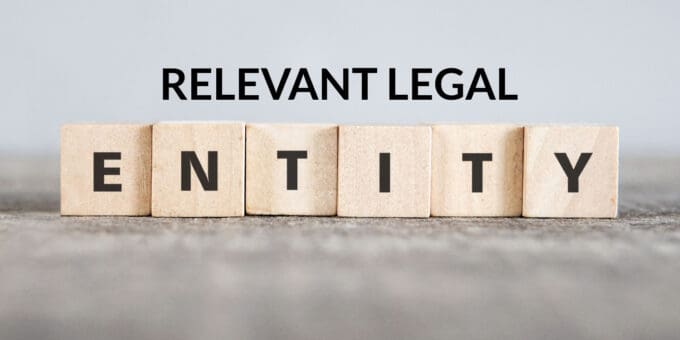A relevant legal entity (RLE) is a corporate body, like a limited company, that would qualify as a person with significant control (PSC) of another company if it were an individual. Essentially, it is a corporate PSC.
If a corporate entity has any level of ownership or control in your firm, you must determine whether it qualifies as a registrable relevant legal entity in relation to your organisation.
In this blog post, we look at the qualifying criteria and the steps you need to take upon identifying an RLE. These include recording certain details in your PSC register, notifying Companies House, and keeping information about registrable RLEs up to date.
Key Takeaways
- A relevant legal entity (RLE) is a corporate ‘person with significant control’ (PSC) that has a certain degree of power or influence over another company (e.g. holds more than 25% of its shares or voting rights).
- UK companies must identify RLEs and record the details of any registrable RLE in the PSC register.
- Within 14 days of obtaining and entering an RLE’s details in the PSC register, the same information must be provided to Companies House.
Identifying relevant legal entities
The requirement to identify and record details of people with significant control (PSCs) applies to all UK companies, limited liability partnerships (LLPs), Societates Europaeae (SEs), UK Societates, and eligible Scottish partnerships (ESPs).
By definition, PSCs are individuals rather than legal entities (e.g. limited companies or LLPs). However, it’s not unusual for corporate bodies to also own or control other companies—for example, a parent company that owns and controls a subsidiary.
In such instances, the corporate body is classed as a relevant legal entity (RLE) if it would qualify as a PSC if it were an individual.
A legal entity is considered relevant in relation to another company if it meets at least one of the qualifying conditions to be a PSC and either:
- keeps its own PSC register or is an ESP and provides information on its PSCs to the central register at Companies House, or
- has voting shares admitted to trading on a regulated market in the UK or European Economic Area (other than the UK) or on specified markets in Switzerland, the USA, Japan, or Israel (listed at the end of this post)
Qualifying conditions
The qualifying conditions to be a PSC are:
- Holding more than 25% of the company’s shares
- Holding more than 25% of the company’s voting rights
- Having the power to appoint or remove a majority of the company’s board of directors
- Exercising, or having the right to exercise, significant influence or control over the company
- Exercising, or having the right to exercise, significant influence or control over a trust or a firm that is not a legal entity that itself satisfies any of the first four conditions
Once identified, a relevant legal entity is registrable in relation to a company if it is the first RLE in the company’s chain of ownership – i.e. it doesn’t hold indirect interests in the company through one or more other RLEs.
Recording relevant legal entity details in the PSC register
A legal entity must be entered in a company’s PSC register if it is both relevant and registrable in relation to that company. Within 14 days of identifying any registrable RLEs, a company must obtain and record the following information about the corporate entity in its PSC register:
- Official name
- The principal or registered office address
- Legal form (e.g. limited company)
- Law by which it is governed (e.g. Companies Act 2006)
- If applicable, the register in which the entity appears, including the country or state where the register is held—if it appears on a register in the UK (e.g. the Charity Commission register) or abroad (e.g. the central public register of companies in another country), this information must be recorded
- Company registration number (or equivalent)
- The date on which it became registrable in relation to the company
- Which of the five qualifying PSC conditions it meets, including quantification of its interest or control, where relevant (e.g. ownership of more than 75% of shares)
Most companies keep their PSC register at their registered office address, making it available for inspection upon request. However, you can also keep a PSC register at a single alternative inspection location (SAIL address) or elect to keep PSC information available for inspection at Companies House instead.
The need to keep a PSC register only applies to companies, LLPs, SEs, and UK Societates. Eligible Scottish partnerships do not have to keep their own register, but they must still provide PSC information to Companies House.
Providing RLE information to Companies House
Within 14 days of obtaining and entering an RLE’s details in the PSC register, you must provide the same information to Companies House.
There is no need to confirm the RLE’s details prior to sending the information to Companies House. This requirement to confirm only applies to the details of individual PSCs.
To tell Companies House about an RLE, you must complete form PSC02 ‘Notice of relevant legal entity (RLE) with significant control’.
You can file this form in one of three ways:
- Online using Rapid Formations free Online Client Portal
- Online via Companies House WebFiling service
- By printing form PSC02 and sending it to Companies House by post
Online filing is the quickest, easiest, and most secure way to deliver this information. In most cases, Companies House will process the form and enter the RLE’s details on the central public register within 48 hours.
The requirement to file PSC and RLE information at Companies House applies to all UK companies, LLPs, SEs, UK Societates, and ESPs.
GOV.UK provides detailed PSC guidance for each type of corporate entity.
Updating the details of a registrable RLE
If the details of a registrable RLE change at any time, you must update the information in your company’s PSC register within 14 days of the change.
Within a further 14 days, you must report the change of details to Companies House using form PSC05 ‘Give notice of change of details for relevant legal entity with significant control’.
You can deliver this form online via Rapid Formations’ free Online Client Portal or Companies House WebFiling service. Alternatively, you can send it by post.
Companies House will update the RLE’s information on the central public register within approximately 48 hours of receiving the form.
If a corporate entity stops being a relevant legal entity
If a corporate entity ceases to be an RLE in relation to your company, you must tell Companies House using form PSC07 ‘Notice of ceasing to be an individual person with significant control (PSC), relevant legal entity (RLE), or other registrable person (ORP)’.
To complete this form, you will need to enter the following details:
- Name and registration number of your company
- Name of the relevant legal entity as it appears on the central public register
- The date on which the entity ceased to be an RLE in relation to your company
- The date on which you made this update to your company’s PSC register
If you file the form online, Companies House will update the public register accordingly within approximately 48 hours.
Confirming RLE details on the confirmation statement
Every year, you must confirm that the RLE details held at Companies House and displayed on the central public register are correct. You will do this by filing a confirmation statement.
If any information about your RLEs or other PSCs is out of date, you will need to update the details at Companies House before filing the confirmation statement. You must ensure this information is accurately reflected in your company’s statutory PSC register.
List of ‘specified markets’
Per Schedule 1 of The Register of People with Significant Control Regulations 2016, below is the list of recognised stock exchanges (‘specified markets’) in Israel, Japan, Switzerland, and the USA:
- Israel—
- Tel Aviv Stock Exchange
- Japan—
- Fukuoka Stock Exchange
- Nagoya Stock Exchange
- Osaka Securities Exchange
- Sapporo Securities Exchange
- Tokyo Stock Exchange
- Switzerland—
- BX Berne Exchange
- SIX Swiss Exchange
- United States of America—
- BATS Exchange, Inc.
- BATS Y-Exchange, Inc.
- BOX Options Exchange LLC
- C2 Options Exchange, Incorporated
- Chicago Board Options Exchange, Incorporated
- Chicago Stock Exchange, Inc.
- EDGA Exchange, Inc.
- EDGX Exchange, Inc.
- International Securities Exchange, LLC
- ISE Gemini LLC
- Miami International Securities Exchange LLC
- NASDAQ OMX BX, Inc.
- NASDAQ OMX PHLX LLC
- The NASDAQ Stock Market LLC
- National Stock Exchange, Inc.
- New York Stock Exchange LLC
- NYSE Arca, Inc.
- NYSE MKT LLC
Wrapping up
By definition, a person with significant control is a natural individual—a human person. However, it’s not uncommon for corporate entities to also own and control other companies. In such instances, if they satisfy certain conditions, these corporate bodies may be classed as registrable relevant legal entities.
Hopefully, you now have a better understanding of the qualifying criteria for registrable RLEs and the steps you must take upon identifying an RLE in relation to your company—recording their details in your statutory PSC register, providing this information to Companies House, and keeping details of registrable RLEs up to date.
If you have any questions about this topic, please leave a comment below. For more limited company guidance and compliance insights, explore the Rapid Formations Blog.
Please note that the information provided in this article is for general informational purposes only and does not constitute legal, tax, or professional advice. While our aim is that the content is accurate and up to date, it should not be relied upon as a substitute for tailored advice from qualified professionals. We strongly recommend that you seek independent legal and tax advice specific to your circumstances before acting on any information contained in this article. We accept no responsibility or liability for any loss or damage that may result from your reliance on the information provided in this article. Use of the information contained in this article is entirely at your own risk.












Join The Discussion